Why isn’t Ecuador the first place to come to mind when Americans think vacation? I cannot think of a destination that is so affordable, accessible and has so much to offer.
Coby and I arrived a few days in advance to get a head start on our acclimatization. Coby is a former college runner and maintains a high level of fitness. Only a couple weeks before our departure Coby sent me message: “Just ran 9 miles at a 6 minute pace.” My response: “I can’t run a 6 minute mile for 1 mile.” On our first night in Quito, the capital city of Ecuador and also the second highest capital city in the world at 9,350ft, we decided to take the TeleferiQo up to an elevation of 13,100ft. Yes, you can take a tram/gondola from the city of Quito straight into the mountains! Once we disembarked the TeleferiQo, we started hiking away from the city to begin our acclimatization and sight see.
Two gringos (no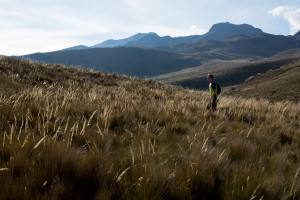 t a derogatory term in Ecuador) walking in the sky trying to get our bearings after a day of travel. Amazingly enough, this spontaneous little trip just outside of Quito turned out to be one of many highlights of the trip. We walked higher and higher always ignoring our lungs’ call for more oxygen. We were warned about being out past dark but we couldn’t help pushing our luck and staying out until the last glimmer of light faded from the slopes of an erupting Cotopaxi in the distance. The view of Quito and the surrounding mountains was unreal.
t a derogatory term in Ecuador) walking in the sky trying to get our bearings after a day of travel. Amazingly enough, this spontaneous little trip just outside of Quito turned out to be one of many highlights of the trip. We walked higher and higher always ignoring our lungs’ call for more oxygen. We were warned about being out past dark but we couldn’t help pushing our luck and staying out until the last glimmer of light faded from the slopes of an erupting Cotopaxi in the distance. The view of Quito and the surrounding mountains was unreal. 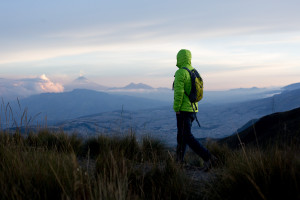 After 11PM in Ecuador the police go home to their families and criminals have their window to cash in. Most of the crime we were told are robberies committed by foreigners who come to Ecuador to get a job. When they are unable to secure a job in their new home, they resort to crime. We finally hurried back to the TeleferiQo and met a very friendly Ecuadorian family who not only offered us a ride back to our hostel, which we accepted, but also invited us to dinner. This being our first night in the country, we respectfully declined their dinner invitation. This was our first introduction to the Ecuadorian culture and hospitality. We later learned from some Canadians who have taken up residence in Ecuador to teach English, it is very common for locals to invite people to dinner and they will not allow their guests to bring anything, help with the cooking or the clean up.
After 11PM in Ecuador the police go home to their families and criminals have their window to cash in. Most of the crime we were told are robberies committed by foreigners who come to Ecuador to get a job. When they are unable to secure a job in their new home, they resort to crime. We finally hurried back to the TeleferiQo and met a very friendly Ecuadorian family who not only offered us a ride back to our hostel, which we accepted, but also invited us to dinner. This being our first night in the country, we respectfully declined their dinner invitation. This was our first introduction to the Ecuadorian culture and hospitality. We later learned from some Canadians who have taken up residence in Ecuador to teach English, it is very common for locals to invite people to dinner and they will not allow their guests to bring anything, help with the cooking or the clean up.
Back to my previous thought process. Why aren’t more Americans going to Ecuador? Can you think of a place where airfare is less than $700, costs $12/night for a hotel, and also has top notch beaches, 20,000ft mountains, and a world famous jungle? All of which have quality roads to them and public transport that cost about $1/hr of travel. In a weeks time you can sunbathe on the beach, walk grassy highlands at 14,000ft and explore the Amazon. For me, it quickly became apparent that Ecuador is still a hidden gem even though the Galapagos Islands and the Amazon are household names. It’s time to change that! Ecuador’s economy is down. Their tourism industry is struggling. The eruption of Cotopaxi, the country’s second highest peak and most famous, has changed the lives of Ecuadorians in an instant. Ramiro, our local guide/translator/driver/negotiator has climbed Cotopaxi 347 times. He has only climbed Cayambe, the country’s 3rd tallest mountain, 14. We need to spread the word that there are so many unbelievable mountains in Ecuador other than Cotopaxi. In fact, Ecuador might be one of the only countries I know of where the highest mountain, Chimborazo, is not the most sought after objective. For those that live in the Southern USA, Ecuador is a 4-6 hour direct flight away. Heck, I might even consider a long weekend in Ecuador!
Back to the trip! The day after our walk in the sky at sunset and our second day in the country, we decided to yet again take the TeleferiQo to 13,100ft, although this time we would climb Pichincha at 15,413ft.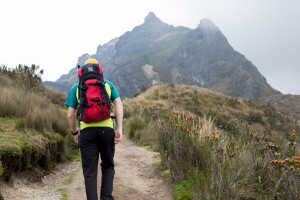 We decided to forgo the normal route and opted for the “Paso de le Muerte” or “Window of Death”. This route leaves the normal trail after an hour and a half and scrambles up 5th class terrain on Rucu Pichincha’s East ridge. We climbed for an hour and a half on 3rd-5th class terrain hooting and hollering and snapping photos the whole way until we reached the summit or “Cumbre.” When the clouds roll in, as they do everyday around 1PM or 2PM, the climbing quickl
We decided to forgo the normal route and opted for the “Paso de le Muerte” or “Window of Death”. This route leaves the normal trail after an hour and a half and scrambles up 5th class terrain on Rucu Pichincha’s East ridge. We climbed for an hour and a half on 3rd-5th class terrain hooting and hollering and snapping photos the whole way until we reached the summit or “Cumbre.” When the clouds roll in, as they do everyday around 1PM or 2PM, the climbing quickl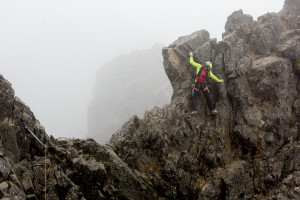 y takes on an amazing alpine feel as you hike or climb on high ridges with clouds swirling around you. The descent was happily uneventful aside from the small hail storm we were in about 20 minutes from the summit. It rained lightly for most of the decent and we arrived back at the TeleferiQo damp, chilled and satisfied.
y takes on an amazing alpine feel as you hike or climb on high ridges with clouds swirling around you. The descent was happily uneventful aside from the small hail storm we were in about 20 minutes from the summit. It rained lightly for most of the decent and we arrived back at the TeleferiQo damp, chilled and satisfied.
We longed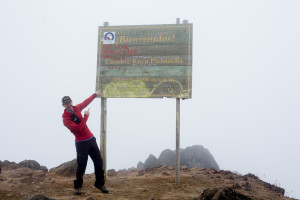 for more ridge climbing and higher altitudes. We caught a ride an hour and a half South of Quito to give Illiniza Norte a try. This 17,000ft mountain offers fantastic ridge climbing up to 4th class. We hiked 2.5 hours to the run down Illiniza Refugio and met a houseful of locals who had come up for the day. Immediately upon walking in the door, they were welcoming us, asking us questions, teaching us how to slightly improve our horrible debauchery of their language, telling us we were “Hermoso” (handsome) and offering us endless cu
for more ridge climbing and higher altitudes. We caught a ride an hour and a half South of Quito to give Illiniza Norte a try. This 17,000ft mountain offers fantastic ridge climbing up to 4th class. We hiked 2.5 hours to the run down Illiniza Refugio and met a houseful of locals who had come up for the day. Immediately upon walking in the door, they were welcoming us, asking us questions, teaching us how to slightly improve our horrible debauchery of their language, telling us we were “Hermoso” (handsome) and offering us endless cu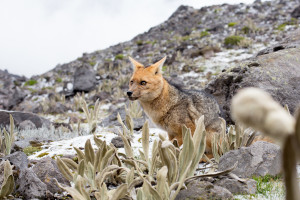 ps of tea. We laughed (mostly at our terrible pronunciation of Spanish words), chatted, and enjoyed the company of our Ecuadorian hosts. The locals left around 3PM and we were left alone in the Refuge to enjoy the sunset and the company of the “pet” fox who has taken up residence at the rufuge.
ps of tea. We laughed (mostly at our terrible pronunciation of Spanish words), chatted, and enjoyed the company of our Ecuadorian hosts. The locals left around 3PM and we were left alone in the Refuge to enjoy the sunset and the company of the “pet” fox who has taken up residence at the rufuge.
We ended up reaching an altitude of 15,900ft on Illiniza Norte before deciding it was a better idea to descend to rest our bodies. We descended to the trailhead where we basked i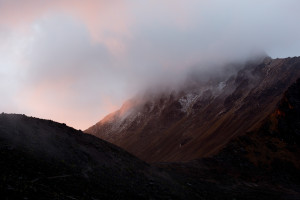 n the morning sun to wait for our ride back to Quito. We didn’t wait long before another local generously offered us a ride back to the sleepy town of El Chaupi at the base of the mountains. We waited outside a cafe for Ramiro to pick us up for the remaining ride to Quito. As we were waiting we saw a man approaching us with bags of groceries in his hands. Freddie, the Refugio Guardian, also happened to own this hotel/cafe/house/hangout in El Chaupi and he welcomed us into his world without hesitation. We were ab
n the morning sun to wait for our ride back to Quito. We didn’t wait long before another local generously offered us a ride back to the sleepy town of El Chaupi at the base of the mountains. We waited outside a cafe for Ramiro to pick us up for the remaining ride to Quito. As we were waiting we saw a man approaching us with bags of groceries in his hands. Freddie, the Refugio Guardian, also happened to own this hotel/cafe/house/hangout in El Chaupi and he welcomed us into his world without hesitation. We were ab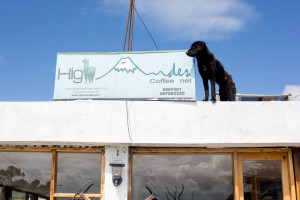 le to get on Wifi (what would we do without it?) and update our family at home, update social media, check email, and occasionally enjoy a few words with Lassie, one of Freddie’s dogs, who spends his days on the roof.
le to get on Wifi (what would we do without it?) and update our family at home, update social media, check email, and occasionally enjoy a few words with Lassie, one of Freddie’s dogs, who spends his days on the roof.
The day had come. Our NEM climbers, Nick, Jen and Peter had arrived and we greeted them at our fantastic hotel in Plaza Foch (pronounced “Forsh”). Nick and his wife, Jen, traveled from Georgia which is a short 4 hour direct flight to Quito. Nick has spent some time climbing with us in the past, most recently 3 days of ice climbing on the coldest days of the year with Coby. They went big and climbed a Winters worth of ice in their short time together. Mountaineering is fairly new to Jen but she arrived with a positive attitude. Ecuador would be her first taste of big mountains and she chose a fantastic location for the introduction. After a briefing about the country and our itinerary, we set off for the town of Otavalo. This culture rich town is home to Ecuador’s oldest market and our base camp for the next three days. Before arriving in Otavalo, we made a stop at the equator or “Mital de Mundo” (Middle of the World). Despite it being a tourist attraction with guides, a museum, and gift shops, we all had a fantastic time and really enjoyed splitting our time between the Northern and Southern hemis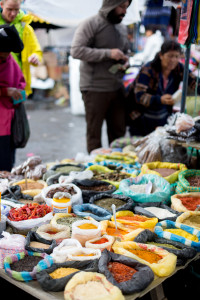 phere. Within an hour of our arrival in Otavalo, we were fully immersed in the market. We all spent a solid 15-20 minutes at one specific “booth”. A traditional Ecuadorian woman had more authentic spices than you could possibly put into 50 different stir fry’s. Peter was particularly blown away by the abundance of fresh spices and herbs. Peter came to Ecuador from sunny San Diego. Like Nick, he had climbed with us in the past, reaching the summit of Mt. Washington in the Winter a few years back. Peter is a strong, charismatic climber full of curiosity and optimism. We made a visit to the market every day while in Otavalo.
phere. Within an hour of our arrival in Otavalo, we were fully immersed in the market. We all spent a solid 15-20 minutes at one specific “booth”. A traditional Ecuadorian woman had more authentic spices than you could possibly put into 50 different stir fry’s. Peter was particularly blown away by the abundance of fresh spices and herbs. Peter came to Ecuador from sunny San Diego. Like Nick, he had climbed with us in the past, reaching the summit of Mt. Washington in the Winter a few years back. Peter is a strong, charismatic climber full of curiosity and optimism. We made a visit to the market every day while in Otavalo.
Our first real acclimatization peak came the next day. Fuya Fuya, named after the plant that grows abundantly on it’s slopes, rises to over 14,000ft. F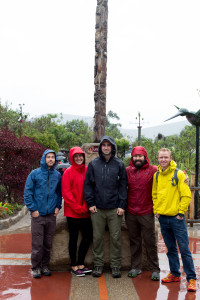 or the most part this climb is an easy scenic hike through grassy highlands to a ridge that separates the two summits. It is short and the scenery is surreal. The equator has 12 hours of sunlight every day of the year so we had plenty of time to complete the hike. We scrambled to both summits and on the descent invented the new sport of “Grassading” which is a variation of “Glissading” or sliding on your butt on snow. Instead, you slide down the mountain on your butt through the tall grasses. We laughed and hollered as if we were kids again. We got quite the kick out of it. On our way back to Otavalo, we stopped at Cuicocha lake whi
or the most part this climb is an easy scenic hike through grassy highlands to a ridge that separates the two summits. It is short and the scenery is surreal. The equator has 12 hours of sunlight every day of the year so we had plenty of time to complete the hike. We scrambled to both summits and on the descent invented the new sport of “Grassading” which is a variation of “Glissading” or sliding on your butt on snow. Instead, you slide down the mountain on your butt through the tall grasses. We laughed and hollered as if we were kids again. We got quite the kick out of it. On our way back to Otavalo, we stopped at Cuicocha lake whi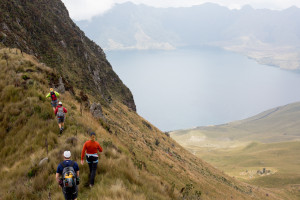 ch is essentially a volcano that collapsed into itself leaving a large lake with an island in the middle. In the USA, this would be a national park (think Crater Lake) and fully exploited for commercial gain. In Ecuador, it is simply a nice view and a good place to enjoy a cup of coffee, which we did. By the way, Ecuador has outstanding coffee!
ch is essentially a volcano that collapsed into itself leaving a large lake with an island in the middle. In the USA, this would be a national park (think Crater Lake) and fully exploited for commercial gain. In Ecuador, it is simply a nice view and a good place to enjoy a cup of coffee, which we did. By the way, Ecuador has outstanding coffee!
I would be remiss if I did not mention the beautiful accommodations we had in Otavalo at the “Posada Del Quinde” or “Inn of the Hummingbird”. The suites and private rooms were extremely clean, well decorated, welcoming and boasted a panoramic view of Imbabura, a 15,000ft extinct volcano. The food was top notch. I had pizza, curry chicken pot pie, and lasagna as my dinners and each one was a good as the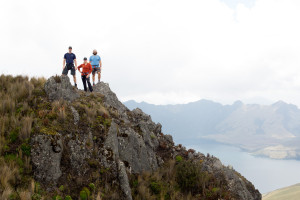 other. We also took advantage of their laundry services for $5. All of our hotels, haciendas, hostels, and refuge stays were really delightful and met or exceeded American standards.
other. We also took advantage of their laundry services for $5. All of our hotels, haciendas, hostels, and refuge stays were really delightful and met or exceeded American standards.
Our next objective was the mountain we had been staring at through our suite window. Imbabura is 15,190ft. Imbabura towers over Lago San Pablo outside of Otavalo. The peak once had a glacier on it and locals from the villages would ascend it’s slopes to get ice which they could bring back to the lowlands. It is a giant mountain, yet no longer has permanent snow on it. We started early (breakfast at 5:30AM) and were on trail by 7:30AM. Only 1 hour into our climb, we looked back to see a dream-like landscape with “God’s Rays” shining down onto what we described as a “Sacred Valley.”
Our team made excellent time up to the ridge where we began 3rd and 4th class scrambling to the s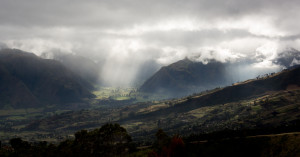 ummit. From trail head to summit was 4.5 hours and some of our climbers had to push hard through the very high altitude. On this day, like many, the summit was in the clouds. We enjoyed the summit for a half hour or so and began our 2.5 hour descent. Only minutes from the top, we met a friend of a friend from Vermont. We chatted a bit and continued the descent. Small world indeed. On the ascent, the trail was slick and muddy in places, but the day had dried things out and the sections we were concerned about, to our relief, were fairly easy to negotiate. The success on Imbabura gave us a lot of confidence in the team and an excellent trip to over 15,000ft.
ummit. From trail head to summit was 4.5 hours and some of our climbers had to push hard through the very high altitude. On this day, like many, the summit was in the clouds. We enjoyed the summit for a half hour or so and began our 2.5 hour descent. Only minutes from the top, we met a friend of a friend from Vermont. We chatted a bit and continued the descent. Small world indeed. On the ascent, the trail was slick and muddy in places, but the day had dried things out and the sections we were concerned about, to our relief, were fairly easy to negotiate. The success on Imbabura gave us a lot of confidence in the team and an excellent trip to over 15,000ft. 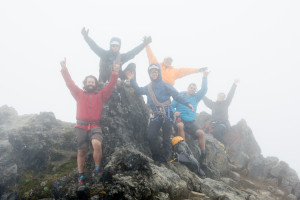
We had successfully climbed to 15,000ft so now it was time to sleep there. We drove to the Cayambe refuge at 15,100ft. We spent the afternoon in the refuge practicing knots and keeping ourselves hydrated. Dinner is included in the refuge and it is fantastic. Dinner usually starts with a delicious potato soup and is followed by some type of chicken dish. One night it was chicken and pasta and another night it was chicken with 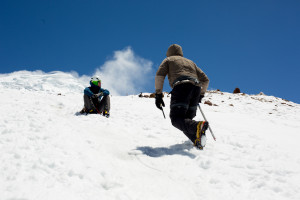 vegetables. A fruit dessert ends the meal. Some of us got some sleep that night and in the morning we started our 1.5 hour hike to the glacier. Since it was our first time sleeping at such an altitude, combined with excitement and anxiety for the next day, sleep is often elusive. We spent most of the next day practicing skills like self arrest, crampon technique, crevasse rescue, and roped travel at 16,000ft. Our team was strong and performed well at this new record altitude for them. We then descended back to Cayambe City to rest and recover before our summit attempt on Cayambe.
vegetables. A fruit dessert ends the meal. Some of us got some sleep that night and in the morning we started our 1.5 hour hike to the glacier. Since it was our first time sleeping at such an altitude, combined with excitement and anxiety for the next day, sleep is often elusive. We spent most of the next day practicing skills like self arrest, crampon technique, crevasse rescue, and roped travel at 16,000ft. Our team was strong and performed well at this new record altitude for them. We then descended back to Cayambe City to rest and recover before our summit attempt on Cayambe. 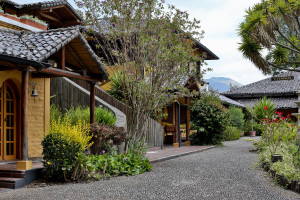
We stayed at our best accommodations so far. A resort that stretches for hundreds of acres with horse pastures, roaming cows, dogs who take themselves for walks and a beautiful Inn. We were sad to see that, because of the tough economy and lack of tourism at the moment, we were the only ones there! We relished in the quiet, tranquil surroundings and everyone slept like a rock that night. Like with any city, Quito and Otavalo are sometimes noisy and street lights can interfere with a good nights rest. Dogs bark, policemen blow whistles, roosters crow, and horns beep. Here at Hacienda San Luis, the night was silent and dark as nature intended. Eggs, bread and fruit are the breakfast staples in Ecuador. Sound familiar? They make an excellent breakfast that fits nicely into our normal diet. A late checkout sent us on our way to Cayambe city to grab lunch and from there, we made the 1.5 hour drive back to the Cayambe refuge. Now when I say 1.5 hour drive, really it should be a 30 minute drive, but the road conditions slowed us down to a crawl for much of the 24km mountain road. The primary roads in Ecuador are as nice as they are in America. The secondary roads are made from small rocks, painstakingly hand placed to provide a solid, durable, somewhat smooth surface for driving on. The tertiary roads are dirt and susceptible to erosion. Cotopaxi is the mountain that everyone and their mother desires to climb. Cayambe is the slightly less aesthetic, slightly lower, way less popular sister to Cotopaxi and because of this, the road to the refuge sees less attention. Near the top, there is a 400 yard section which consists of strictly rocks the size of basketballs which must be negotiated with skill and great care in order to avoid hiking an hour to the refuge. The van creaked and groaned as we wound our way up the steep switchbacks and through some flat spots where the lunar landing could easily have been filmed. We arrived at the refuge full of excitement for our summit attempt. Team morale was at a high.
The reality of the mountains hit hard. We woke up at 11PM to find Nick suffering from digestive issues. These issues along with respiratory issues are fairly common while traveling in foreign countries and spending time at altitude. It quickly became evident his summit attempt was over before it started. I decided to stay with him and make sure he had someone around to help him should he need it. Coby and Ramiro set off into the night with Peter and Jen, sights set on the summit. Around 7AM Coby arrived back at the hut with Jen who reached her high point of 17,100ft. A fantastic accomplishment in its own right and nearly 3,000ft higher than any mountain in the lower 48 states. Ramiro and Peter reached the summit after 6 hours of hard work where they enjoyed the reward they had earned. The day was mostly clear with low clouds covering the valleys. Giant mountains shot out of the cloud layer like islands in the sky. It was warm and sunny as they stood at nearly 19,000ft. When an expedition puts climbers on the summit, even if it is only a fraction of those who set out for it, the expedition is a success (the first ascent of Everest was a HUGE assault on the mountain with hundreds of people involved and only two stood on the summit). Some may argue that without the supporting team members, their success may not have been realized. In our case, we were thrilled for our teammates success on Cayambe!
Most of us fell asleep on the bumpy drive back down the mountain as only a couple of us got any sleep at all before the summit attempt. We drove to our hotel and immediately fell asleep. We woke up for dinner and a quick tour of the town and then retired for the night.
On our last real day of the itinerary, we drove to Thermas de Papallacta. This is a 5 star resort and spa at the edge of the Amazon. Cheap massages, excellent food, hot springs of all different temperatures, and heated pools outside our bungalow door. We checked in, and only 2 hours later, we checked out.
Not all of us left. Jen and Peter stayed with Ramiro at the spa, relishing their accomplishments on Cayambe and pampering themselves after a hard week of climbing and pushing themselves to new altitudes. Ramiro offered to drive Coby, Nick (now recovered from his illness) and myself back to Cayambe city. We needed to right the wrongs. We needed redemption. Once in Cayambe we hired a truck to bring us the hour and a half back to the Cayambe refuge. We longed for our enclosed van. We rode in the bed of the cattle truck and got tossed around arriving at the refuge covered in dust with black rings around our nostrils. We didn’t care. It was part of the new adventure we found ourselves on. “The adventure begins where the plan ends.” On our previous summit attempt the refuge was at capacity however that requires only 20 people. On this attempt the refuge had 70 people in it plus many more camping nearby. They were clearly struggling to keep up with with the demand that is now focused on Cayambe in Cotopaxi’s hiatus. We “slept” on benches while other climbers from around the world slept on the floor or on the dinner tables. It was a mad house but it didn’t matter. We didn’t plan on sleeping anyways. We were happy as clams because had another shot at the summit! Every group going for the summit left between 11:30PM and 12AM. Knowing we would climb fast, we planned to leave at 1AM. 12:40AM came around and we couldn’t wait any longer. We clicked on our headlamps and headed out into the a clear, windy night.
We reached the glacier in 1/3 of the time it normally takes guided groups. We passed several groups on the rock and scree slope. We were full of stoke and ambition and maybe a bit of competition. We roped up at the glacier and began the ascent in the midst of about 50 other climbers. We were determined to have the summit to ourselves. Throughout the next hour and a half we dashed in and out of groups at a blistering speed of about 1/2 mile an hour. Painfully slow by White Mountain hiking standards but just fast enough to pass every other group (besides a group of 2) on the mountain. By the time we reached 17,000ft. We had the upper mountain to ourselves. The vibrant stars became obscured by clouds and limited visibility. We climbed the moderate snow slopes above and navigated around and over crevasses to reach the summit at 5:35AM. We had climbed Cayambe in just under 5 hours! 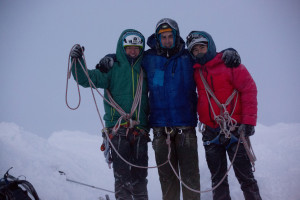 A few hours quicker than a normal time. The day was just beginning. We shut off our headlamps as the sun came up. Unfortunately we could only tell it was daytime by the gradual increase in illumination of the ping ping ball we were in. We had 100 feet of visibility which made our summit photo looks as if we were in an L.A. Studio with a white background. It was cold. The wind cut hard through our soft-shell pants, and the rime ice built up on every surface. Coby used the adze of his ice axe to scrape away the rime from his watch. We lingered for 20 minutes or so before hightailing it back to the safety of the refuge passing other teams still on their way up. We descended the last hour in a light mist/sleet. The wind did not relent. The warmth of the refuge was a welcomed sight and we sat in our damp climbing clothes again chilled, tired, and satisfied. We had scrambled eggs and hot tea which brought some life back into us before Juan, our driver who was full of enthusiasm, compassion and generosity, arrived. We loaded into the back of the truck, completely content, and prepared ourselves for the dust storm.
A few hours quicker than a normal time. The day was just beginning. We shut off our headlamps as the sun came up. Unfortunately we could only tell it was daytime by the gradual increase in illumination of the ping ping ball we were in. We had 100 feet of visibility which made our summit photo looks as if we were in an L.A. Studio with a white background. It was cold. The wind cut hard through our soft-shell pants, and the rime ice built up on every surface. Coby used the adze of his ice axe to scrape away the rime from his watch. We lingered for 20 minutes or so before hightailing it back to the safety of the refuge passing other teams still on their way up. We descended the last hour in a light mist/sleet. The wind did not relent. The warmth of the refuge was a welcomed sight and we sat in our damp climbing clothes again chilled, tired, and satisfied. We had scrambled eggs and hot tea which brought some life back into us before Juan, our driver who was full of enthusiasm, compassion and generosity, arrived. We loaded into the back of the truck, completely content, and prepared ourselves for the dust storm.
A truck ride, a bus ride, and several cab ri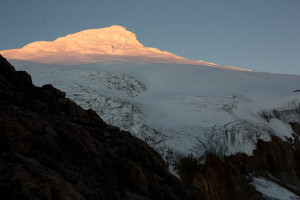 des got us to our hotel and a very restful nights sleep before our flight early the next morning. Now back in the office, I still have moisture in my camera lens. A fine reminder of our unlikely, last ditch effort ascent of Cayambe and the adventure shared by 6 climbers from New Hampshire, Georgia, California and Ecuador.
des got us to our hotel and a very restful nights sleep before our flight early the next morning. Now back in the office, I still have moisture in my camera lens. A fine reminder of our unlikely, last ditch effort ascent of Cayambe and the adventure shared by 6 climbers from New Hampshire, Georgia, California and Ecuador.

 We are proud to work with the Department of Agriculture, the White Mountain National Forest and the Androscoggin Ranger District where we are authorized outfitter guides.
We are proud to work with the Department of Agriculture, the White Mountain National Forest and the Androscoggin Ranger District where we are authorized outfitter guides.
